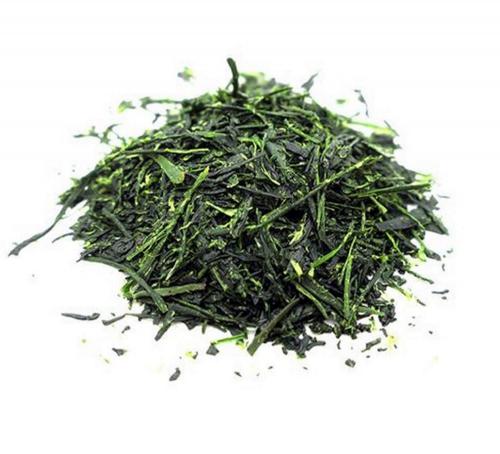Sencha Green Tea, Japan

Sencha Green Tea, Japan - is a deep green or Jade in color tea with an amazing smell especially when you just steep it for brewing.
Among the Senchas are the famous top Sencha Yame Saemidori from Saemidori cultivar that is broken into smaller needles than the Yabutika. Saemidori is essentially the first cut baby greens of light color harvested first time in April. This Sencha is a deep green with a more intense spinach flavor.
There are many types of Sencha: Shincha (the first Sencha of the season), Asamushi (lightly steamed), Chumushi (moderately steamed), Fukamushi (deeply steamed), Kabusecha (grown in shade or covered), Hachijuhachiya Sencha (picked on the 88th day after Risshun), Jo Sencha (high quality), and Toku Jo Sencha (extra high quality). Lightly steamed Senchas tend to be more mild in flavor whereas the deeply steamed Senchas tend to be very strong in flavor. It can be good to experiment with different types of Sencha to determine which you enjoy best.
Sencha Yabukita
Yabukita is a breed of tea bush, or 'chanoki', which is native to Shizuoka. This tea cultivar represents about 70% of the tea production area in Japan. It is known as an excellent breed, and its fragrance and flavor are generally considered the standard of Japanese green tea.

Source: The Tea makers of London Supreme Japanese Sencha-No. 69. This supreme Sencha green tea from Ise Bay, Mei perfecture Japan imparts an outstanding flavor and intoxicating fresh aroma.
Preparation of Sencha
Process
4-5 gm leaves for two cups
200 ml water
70-90 degrees’ Celsius water temperature
Brew for 30 seconds to 1 minute (You may Brew for up to 2 minutes till you find which variables suit your taste).
Sencha Yabukita can have notes of juicy green apple and guava or completely grassy (different Senchas from Japan will have different smell and notes depending on the region and soil). The flavor can be grassy, floral, umami, or all at once if sencha from different regions is blended.
Cultivated and grown in shading process called Kabusecha to retain higher levels of chlorophyll, caffeine and L-theanine. In the final days before harvest the tea leaves are exposed to sunlight to increase the level of catechins. Good quality of Sencha will drop and roll down in the form of needles of somewhat similar size after completing the processing.
The difference between the Japanese Sencha and the Chinese Sancha is that the Japanese sencha is steamed for about one minute whereas, in China the leaves are heated in a pan.
The uniqueness of the Japanese steaming process is that within that one minute the enzymes that cause oxidation is deactivated. Tea leaves become softened after steaming. This is followed by oven drying process to bring down humidity levels to 4-7 per cent. Further the leaves are tightly rolled into needle shape and that's why they must be steeped for a full minute while brewing the first time.
Note: You can use the Sencha leaves 3-4 times and get different color, taste notes, strengths and flavors. The first brew is likely to be the sweetest or more savory. If you go beyond the third brew, you should up the temperature. It is said that the first three steeps give the most value of L-theanine, Catechins and Caffeine. The fourth or fifth steep will tend to be more dry, astringent and energetic or even bitter.
In the first steep as the leaves take a little time to open you can brew the leaves up to 2 minutes, but in the second or third steep you should brew only for a few seconds.
Hotter water will draw savory grassy tones with yellowish color tea while cooler water will draw more green color and sweeter notes. Yabukita is considered as the quint-essential flavor of Sencha Japanese tea. Sencha Yabukita is a well balanced flavor with almost no astringency and perfect umami.
The lesser time you brew, the more brothy and/or voluptuous after notes and maybe a dopamine kind of effect in your brain. The longer you brew the sencha the thinner notes and dryness may be present or even taste bitter. Green teas especially Senchas are all about bringing about that balance of the three main quality constituents at play:
L-theanine amino acids (contributing to the thicker brothy and sweeter notes)
Catechins (bringing about bitter and drier taste), and
Caffeine giving (more dryness and astringency).
Steeping at a lower temperature will not release antioxidants, catechins, and caffeine, but release L-theanine. At the same time, you would want to enjoy quicker, the cooler brew before some valuable amino acids evaporate into the air.
Advertise on APSense
This advertising space is available.
Post Your Ad Here
Post Your Ad Here
Comments